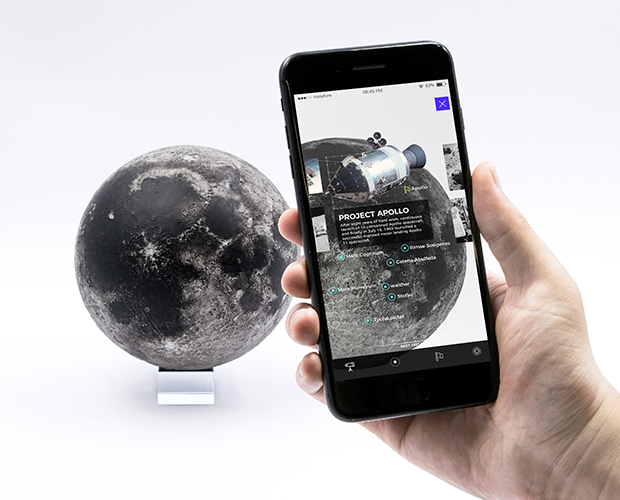Want a Closer Look at the Moon? Try It in AR with This Lunar Model and App
No telescope? No problem! Now you can explore all the nooks and crannies of the moon in the palm of your hand using a 3D-printed moon model and augmented-reality (AR) app.
Created by the San Francisco-based company AstroReality, the new moon model — called "Lunar" — is covered in craters, mares, dead volcanoes and other features of the moon that you can inspect virtually using the accompanying AR app.
AstroReality's designers used real data from NASA's Lunar Reconnaissance Orbiter to create the textured models. Precisely printed with a resolution of 0.006 millimeters per pixel, the Lunar models are scientifically accurate. And with a hand-painted finish, they're also beautiful to look at. [Latest Moon Photos from NASA's Lunar Reconnaissance Orbiter]
The real fun comes in when you install AstroReality's AR app, which allows you to investigate features across the lunar surface. Identifying craters and mares is only the beginning; you can also scope out landing sites for NASA's Apollo missions. Click on one of these landing sites and you'll see photos, videos and other mission information pop up.
You can even see China's Yutu moon rover, which landed on the moon in December 2013 as part of China's Chang'e 3 mission. It spent 31 months roving around the lunar surface before it died.
For now, the product is still in its "prototype stage" as AstroReality's developers continue to make improvements and add new features to the app. For the Lunar Pro model, the company is developing a series of "moon tasks" in which users can simulate things Apollo astronauts did on the moon virtually using the AR app, AstroReality's lead producer Joanne Dai told Space.com.
AstroReality's moon model comes in three sizes, and you can buy them here through IndieGogo. Getting your hands on one of these moon models will take some patience, though – they won't ship until January 2018.
Breaking space news, the latest updates on rocket launches, skywatching events and more!
The largest model, the Lunar Pro, is about the size of a grapefruit and is on sale for $200. The "regular" size has a diameter of about 3 inches (8 centimeters) and costs $89, while the "mini" version measures a little over an inch across (3 cm) and costs $49. Prices have been marked down by up to 28 percent, so if you're interested in buying one of these, now would be a great time to do that.
Although the moon models are made of a sturdy polyresin material, Dai recommends adult supervision for children younger than 14 to avoid accidental damage to the model. Still, it is "a great tool for youngsters to learn about the moon," Dai said.
If you're a fan of space exploration and augmented reality, AstroReality has plans to roll out similar 3D-printed models of planets in the solar system, starting with Mars, Dai said.
AstroReality's IndieGogo campaign has managed to raise nearly $200,000, or more than five times their fundraising goal. Even though the campaign has ended, you can still order the items via IndeGogo indefinitely. And once the AstroReality website is finished later this year, they'll be for sale there as well.
Email Hanneke Weitering at hweitering@space.com or follow her @hannekescience. Follow us @Spacedotcom, Facebook and Google+. Original article on Space.com.

Hanneke Weitering is a multimedia journalist in the Pacific Northwest reporting on the future of aviation at FutureFlight.aero and Aviation International News and was previously the Editor for Spaceflight and Astronomy news here at Space.com. As an editor with over 10 years of experience in science journalism she has previously written for Scholastic Classroom Magazines, MedPage Today and The Joint Institute for Computational Sciences at Oak Ridge National Laboratory. After studying physics at the University of Tennessee in her hometown of Knoxville, she earned her graduate degree in Science, Health and Environmental Reporting (SHERP) from New York University. Hanneke joined the Space.com team in 2016 as a staff writer and producer, covering topics including spaceflight and astronomy. She currently lives in Seattle, home of the Space Needle, with her cat and two snakes. In her spare time, Hanneke enjoys exploring the Rocky Mountains, basking in nature and looking for dark skies to gaze at the cosmos.



